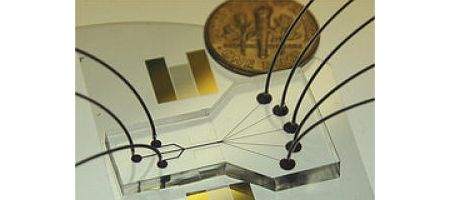A device that sorts cells using acoustic waves could lead to the creation of miniature medical analytic devices that fit in a pocket.

It uses two beams of sound waves to act as acoustic tweezers and sort a continuous flow of cells on a dime-sized chip. And by changing the frequency of the acoustic waves, researchers can easily alter the paths of the cells.
Since the device can sort cells into five or more channels, it will allow more cell types to be analyzed simultaneously, which paves the way for smaller, more efficient and less expensive analytic devices.
“Eventually, you could do analysis on a device about the size of a cell phone,” says Tony Jun Huang, associate professor of engineering science and mechanics at Penn State. “It’s very doable and we’re making inroads to that right now.”
Biological, genetic and medical labs could use the device for various types of analysis, including blood and genetic testing, says Huang.
“Today, cell sorting is done on bulky and very expensive devices,” he says. “We want to minimize them so they are portable, inexpensive and can be powered by batteries.”
Using sound waves for cell sorting is less likely to damage cells than current techniques, he says.
The researchers created the acoustic wave cell-sorting chip using a layer of silicone. Two parallel transducers, which convert alternating current into acoustic waves, were placed at the sides of the chip. As the acoustic waves interfere with each other, they form pressure nodes on the chip; and, as cells cross the chip, they are channeled toward these pressure nodes.
The transducers are tunable, which allows researchers to adjust the frequencies and create pressure nodes on the chip.
The researchers have tested the device by sorting human white blood cells affected by leukemia. The leukemia cells were first focused into the main channel and then separated into five channels.
“We can do more,” says Huang. “We could do 10 channels if we want – we just used five because we thought it was impressive enough to show that the concept worked.”






